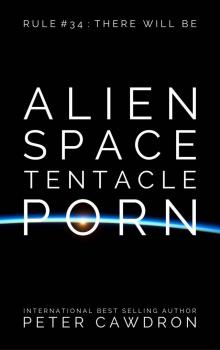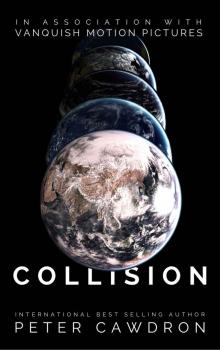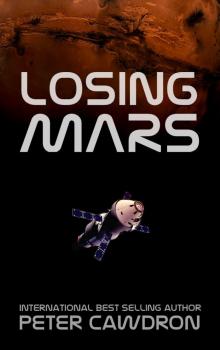- Home
- Peter Cawdron
Losing Mars Page 3
Losing Mars Read online
Page 3
“It’s cold out here.” I glance at my wrist pad. “Temperature is minus eighty.”
At noon, the temperature on Mars hovers around freezing, with the occasional summer day hitting a balmy seventy degrees. Most of the time, it’s subzero. Way below zero. Over a hundred degrees below zero, which is so insanely cold it makes no sense to my mind. Intellectually, I understand it, but practically, it’s surreal. So intensely cold, but no snow—not where we are near the equator. The thermal insulation in my surface suit creates an illusion of normalcy—making my suit seem like ski gear, but the cold seeping through my boots doesn’t lie. The temperature on Mars is currently akin to winter in the furtherest reaches of Antarctica, but it’s late spring here.
I skip forward, finding it easier than either walking or bunny hopping. Stones crunch beneath my boots, shifting slightly as I skim over them, moving toward the entrance. Jennifer can see the feed from the camera on the side of my helmet, but I provide commentary anyway. Habit.
“Approaching the rover.”
Light catches dust particles suspended in the air by the opening of our artificial cave.
Originally, Shepard was going to be built in lava tubes or natural caves to protect the crew from cosmic radiation, but that severely limited the possible locations for the base.
Cosmic radiation is a serious problem for us. Far from being empty, space is more like a snooker table. Stars explode or collide and that’s the white ball being smacked with the cue stick. Individual atoms go flying off at close to the speed of light. Regardless of how small they are, anything traveling that fast is dangerous. Even though space is a vacuum, given enough time, atoms will eventually collide with each other and—bang—the cosmic game of snooker just got interesting. Protons, neutrons and electrons scatter again, speeding along until they hit something else. If that something else happens to be alive, that’s bad—destroying cell walls and damaging DNA.
The magnetic field surrounding Earth herds these celestial snooker balls to the poles where they light up as aurorae. Plenty of cosmic rays still get through, though, but nowhere near as many as could—except for somewhere like Mars. No global magnetic field means no protection.
To shield us astronauts, Shepard was buried beneath eight feet of loose regolith. The base was created using 3D robotic fabrication units sent in advance to manufacture Quonset huts—long half-pipes forming an artificial tunnel on the surface of the planet. Once built, they were buried by robotic workers that dragged rocks onto the roof. In someways, Shepard looks like one of the military aircraft bunkers common throughout the Middle East.
When viewed from orbit, Shepard appears as a series of mounds in the shape of an X, but only three of the four Quonset huts are habitable, with the last being used as a sheltered entrance and garage for external equipment.
I climb onto a rover. In the movies, charismatic actors with dazzling white teeth get to drive across Mars in style, lounging in comfortable RVs. In reality, it cost two billion dollars and an entirely separate launch to land what’s little more than a bare-bones chassis with eight wheels. I don’t care. The final decision was based on simple math—one Winnebago or three dune buggies. Having redundancy won the day.
Being stripped down and lightweight, the rovers get far better mileage anyway and are quite nimble over the rough terrain. They’re capable of climbing slopes of up to thirty-five degrees without any danger of rolling. Doesn’t sound like much, but the steepest crater I’ve gone over topped out at around twenty-seven degrees. It felt like I was climbing straight up a brick wall.
With gravity at one-third what’s experienced on Earth, suspension isn’t too much of a concern. It may be reckless, but I find it surprisingly easy to get a rover airborne over sand dunes. For the first few seconds, life unfolds in slow motion until the pull of an entire planet obliges and the rover comes down in the soft sands. In low gravity, sand moves more like shallow water, or perhaps mud, making its motion somewhat hypnotic to watch as it sprays out from beneath the wheels. I was reprimanded, of course. These days, my communications equipment tends to play up whenever I’m near the dunes. Perhaps there are radio black spots. Perhaps Lisa needs to rebuild the electronic relay on the rover. Perhaps I accidentally bump the wrong setting. I’m not sure what goes wrong—at least, that’s the official story. Regardless, communication is generally restored once I exit the dunes. Houston has been understanding, something that surprised me at first. It shouldn’t have. They’re human. They know there’s a need to let off steam every once in a while.
Like the Apollo lunar rovers in the 1970s, no consideration has been given to aesthetics or comfort. Getting from A to B in a safe, timely manner is all that matters on Mars. There’s no cabin. No windscreen. No steering wheel. No dashboard. No engine hood.
I sit in a mesh seat supported by thin aluminum tubes. The rover is steered by a joystick set between the two seats so the vehicle can be driven from either side. My Martian coupe uses an electrical engine driven by an array of six batteries. The rover has been painted fluorescent green so it can be seen at a distance and easily tracked from orbit. Behind the seats there’s a standard set of emergency equipment—spare wheel, additional batteries, flares, winch, hydraulic jack, an insulated pop tent that can’t be pressurized but can be heated against a night spent away from base, additional oxygen, CO2 scrubbers, and a block of water ice sealed in plastic, with an internal heater that can melt it if need be.
Dust covers a small screen set at waist height between the seats. I punch a few buttons with my thick, gloved fingers and the display springs to life. I wipe the dust away. A map appears, highlighting nearby waypoints. I pan to the north, looking for the edge of the canyon.
“I don’t see them.”
Jen replies, “Patching through coordinates.”
“Thanks. Do we have any imagery yet?”
“Lisa’s got a boomer inbound. Should have a feed by the time you’re onsite.”
“Perfect.”
Perfect overstates the point, but I’m trying to put everyone at ease, including my wife. We’re well over a hundred million miles from home at this point in our orbit, so I’ll take anything I can to calm our collective nerves.
“Going through diagnostics.”
I begin reviewing the various subsystems on the rover, including radio boost and telemetry. A wiry smile appears on my face as I plot a course to the edge of the canyon.
“Shepard, are you seeing this?”
With only four GPS satellites in orbit around Mars, my position is approximated to within thirty feet and shows the vehicle apparently sitting outside the tunnel.
“Let me guess,” Jen says. “You’ve teleported outside the base.”
“Something like that.”
The fictional concept of teleporting triggers something in the back of my mind.
“Hedy, do we have any indication of whether we’re dealing with a TOS, TNG or DS9 out there? Over.”
“Ah, I’ll get back to you on that one.”
I smile, knowing I’ve got them scrambling to figure out what the hell I’m talking about using a bunch of acronyms that aren’t part of the mission profile. With my transmission being relayed to Earth, in roughly half an hour someone down there is going to smile as well once the realization hits. I continue working through the rover checklist, ensuring the vehicle is Mars worthy.
Jen comes on the channel less than a minute later, sounding a little sassy.
“Can confirm this is an S-T-3. That’s three. Over.”
Jen’s got my measure. As tense as the moment is, I’m trying to inject some levity and not become too narrow in my focus. We’ve been married for nine years. Jen knows my quirks and idiosyncrasies all too well. Once she realized the acronyms were fake, she picked up on the pattern. TOS—The Original Series. TNG—The Next Generation. DS9—Deep Space Nine. Her reply, though, has me stumped for a second as she’s referring to a movie rather than a TV show, but it’s perfect. ST3—Star Trek III: The Search
for Spock.
I laugh. “Okay then. This is Cory Anderson, outbound from Shepard in R2, in search of Scott.”
“Copy that.”
In my mind’s eye, Hedy’s shaking her head, Lisa’s laughing, and Jen has a massive grin on her face. There’ll be plenty of time to be serious later.
I drive out onto the surface of Mars. The sky is dull and overcast—a pale, sickly yellow. Sand has built up against the eastern side of the base, drifting with the prevailing winds. Distant mountains are but a faint outline, obscured by the dust haze.
Gravel litters the ground, half buried in the sand. Sharp rocks protrude from a low dune. The ground is covered in stones. It’s as though the entire planet is a quarry and has been subject to mining blasts obliterating the rock. In some ways, it is, only the explosions have come from innumerable meteor impacts over billions of years, slowly pulverizing the rock. Light patches of sand give way to deep oranges and reds—iron oxides exposed on the surface. Rolling hills, shattered mounds, craters and rock piles scar the land. Layer upon layer of rock, eroded by exposure to ancient floods and hundreds of millions of years worth of prevailing winds. Mars is a graveyard.
Every geological feature around Shepard has a name, often nicknames assigned by various astronauts or mission controllers. I steer between IHOP and T1000, following the outbound tracks of the first rover.
IHOP is a rocky outcrop named after the International House of Pancakes. It’s a series of eroded sandstone layers stacked on top of each other, just waiting for a dollop of cream and some maple syrup.
T1000 is an iron core meteorite fragment the size of a laundry basket. Shiny, dark, smooth, pitted iron half buried in the shifting sands. One of the mission controllers back in Houston commented on how it looked like the liquid metal robot from an 80’s movie and the name stuck. It’s the kind of thing that would be proudly displayed in a museum on Earth. On Mars, it’s little more than a signpost. Before long, one of the 3D printers will consume it for raw materials.
Shepard is located on the southern rim of the Eos Chaos, a point of transition between the Valles Marineris and the flood plains of the north. The selection of the site was a compromise between conflicting priorities. Planetary protection measures dictated caution to avoid contaminating locations that may still harbor microbial life, while researchers wanted to maximize their ability to learn about the history of the planet.
The Eos Chaos exposes rock strata spanning billions of years. In the same way that the Grand Canyon is a geological textbook on Earth, the Eos provides easy access to the various epochs on Mars, including deposits of clay, silt and sandstone laid down by floodwaters hundreds of millions of years ago. From Shepard, boomers can traverse the highlands and canyons to the west, the valleys and floodplains to the north, and the crater fields to the south and east, making it an ideal central point for the research station. Also, being close to the equator gives us a bit of a boost when launching into orbit as we gain some speed from the rotation of the planet itself.
Shepard base was named after Alan Shepard, the first American in space. Unfortunately for Alan, his was a suborbital flight and, as the US was playing catch up with the Russians, it didn’t count with the media who called it a “modest leap compared with… Yuri Gagarin of the Soviet Union.” They described Alan’s splashdown as dropping “gently to the water.” In reality, Shepard endured nine g’s launching on top of a prototype Redstone rocket, which is three times that experienced by astronauts on a Falcon Heavy. Reentry was worse, maxing out at eleven times the gravity felt on Earth—more than that of the gas giant Saturn.
Months later, John Glenn became the first American in orbit and Alan became a byline. He stayed on for the Gemini program but was grounded due to medical issues. Somehow, he made his way back onto the roster for the Apollo missions and successfully landed on the Moon. Alan smuggled a couple of golf balls to Fra Mauro and left a few divots with a 6-iron screwed on the end of a soil collector. The Moon, it seems, is one giant sand trap.
Could there ever be another Alan Shepard? I’d like to think so.
Shepard’s first flight was in a glider he made with his best friend. After reaching the grand height of four feet, the glider stalled and crashed, but for Alan, failure was a step beyond inaction. Flight was a passion that couldn’t be extinguished. Mistakes were opportunities to learn.
Shepard flunked the Navy’s flight school and was sent “back to the bilge pump,” being returned to his ship in the Pacific, but he wouldn’t quit. After gaining a civilian pilot license, Alan attended the Naval Air Station in Pensacola and went on to become a test pilot and instructor.
Looping the Chesapeake Bay Bridge in an experimental aircraft and buzzing the beaches of Ocean City had him on the verge of being court marshaled and thrown out of the Navy. Film emerged of women clinging to their bikinis as his jet roared over the sand dunes, but somehow he avoided ruining his career.
When Sputnik passed overhead, Shepard spotted “the little rascal” in the night sky and decided to be part of the solution. His pragmatic approach to spaceflight instilled a sense of adventure into NASA with observations such as, “you spend far more time planning and training and designing for things to go wrong, and how to cope with them, than you do for things to go right.”
Shepard’s maiden spaceflight on Freedom 7 was given an eighty-eight percent chance of success, which sounds like a lot but that’s a one-in-ten chance of failure—roughly the same odds as catching the flu in any given year. Shepard didn’t care. He wanted to launch regardless.
For me, Alan Shepard isn’t a legend so much as an inspiration. He isn’t just some vague black and white footage of an astronaut being used as a guinea pig. In my mind, he epitomizes courage—being the first American to strap himself inside the nose cone of an intercontinental ballistic missile and trust in the professionalism and dedication of thousands of engineers and scientists. There’s a million ways a launch can end up as a fireball billowing through the clear blue sky. Dumb luck never paved the way to space. It required trust in physics. Successful launches lie within a very narrow range between controlled explosion and catastrophic failure. They’re a tightrope walk over the Grand Canyon without a safety harness. Space flight has always been about trusting science over entropy—Yuri, Alan, John, and Neil all walked the same line we do here on Mars.
Rockets have safety systems, but in the US at least their effectiveness has never been demonstrated during an actual disaster. Like most astronauts, I made the mistake of asking about safety during training. My instructor tried not to laugh. “The abort system produces eighteen to twenty gees as it catapults you the hell away from any fireball, but it’s a mixed blessing. How safe would it be to pile eighteen to twenty people directly on top of you? You’ll probably survive. Probably. But you won’t be walking away from an abort.” Yeah, okay. Dumb question.
The first launch I watched in person was the deployment of the Vera Rubin Space Telescope. Several of us astronauts were invited as observers located in the control block five miles from the launch pad. At that distance, the roar of the engines arrived as a wall of sound several seconds after the rocket had cleared the pad.
The first launch Alan Shepard watched was conducted at the then Cape Canaveral and ended up in a fireball a couple of hundred feet above the concrete. I find it fascinating that Alan and the rest of the Mercury Seven didn’t walk away at that point. For me, that typifies what it means to be an astronaut—endless optimism in the ability of scientists and engineers to harness the laws of nature. Gravity may bend spacetime, but Homo sapiens have learned to manipulate the universe itself.
I steer north from Shepard base. Rocks litter the ground. I accelerate, following fresh tracks toward the edge of the canyon.
“Patching you through to Sue.”
“Cory?”
“I’m outbound, Sue. On my way. ETA eleven minutes. How is he?”
“I—I can’t see him. He’s alive, but he’s not responding. I tried to
reach him.”
“Hold tight. I’ll be there as soon as I can.”
Pure O2—that’s why I’m out here and not someone else. Funny how the tiniest of circumstances shape the future. I wonder about Scott. Six humans on Mars, but only two men. At first, it was controversial—not for me or any of the crew, but there was resistance. Public perception is slow to change. Space men. Manned spaceflight. Giant leap for mankind. I was labeled a cuck because Hedy was selected as second-in-command over me. I had to defend what needed no defense—that astronaut selection was about finding the best people for the mission. Period. The only considerations were experience and ability. If that had meant a crew of six men or six women, so be it, but now two is in danger of becoming one.
In the back of my mind, I can hear Jenny telling me not to be a hero. She’s right. That’s the danger. Try too hard and one could become none.
“Hang in there, Scott.”
Rescue
“Shepard, I have visual on the primary rover. Visual on one astronaut. Repeat. One. Over.”
“Copy that.”
It’s just nerves, but as I approach I feel compelled to ask the obvious.
“Comms check.”
“We are receiving audio and video from your head cam. Relay boost through the rover is clean. Reception is good. No interference. Confirm your last visual on approach—one rover, one astronaut.”
“Copy.”
I bring my rover to a halt ten feet from the first rover, well back from the edge of the canyon. Sue is quiet, which is unsettling. She’s got to be listening on the common channel. She rummages in the back tray of her rover, looking for equipment, but something’s wrong. She’s been out here for a couple of hours. It’s been at least forty minutes since the fall. She’s long past grabbing anything she needs. She’s busying herself, or at least trying to appear busy. With her head down, her helmet blocks her periphery vision—a somewhat convenient way of avoiding eye contact. She’s hurting emotionally, far more than she’s let on to Jen or Hedy. I instinctively recognize that in the way her gloved hand shakes as she grabs a toolkit.

 Alien Space Tentacle Porn
Alien Space Tentacle Porn Reentry
Reentry Déjà Vu (First Contact)
Déjà Vu (First Contact) Wherever Seeds May Fall (First Contact)
Wherever Seeds May Fall (First Contact) But The Stars
But The Stars Trixie & Me
Trixie & Me Collision
Collision Jury Duty (First Contact)
Jury Duty (First Contact) Losing Mars
Losing Mars We Are Legion (van Helsing Diaries Book 2)
We Are Legion (van Helsing Diaries Book 2) Van Helsing's Diaries (Books 1-3): Nosferatu
Van Helsing's Diaries (Books 1-3): Nosferatu Shadows
Shadows 3zekiel (First Contact)
3zekiel (First Contact) Vampire (van Helsing Diaries Book 1)
Vampire (van Helsing Diaries Book 1) Xenophobia
Xenophobia All Our Tomorrows
All Our Tomorrows My Sweet Satan
My Sweet Satan Anomaly
Anomaly Monsters
Monsters